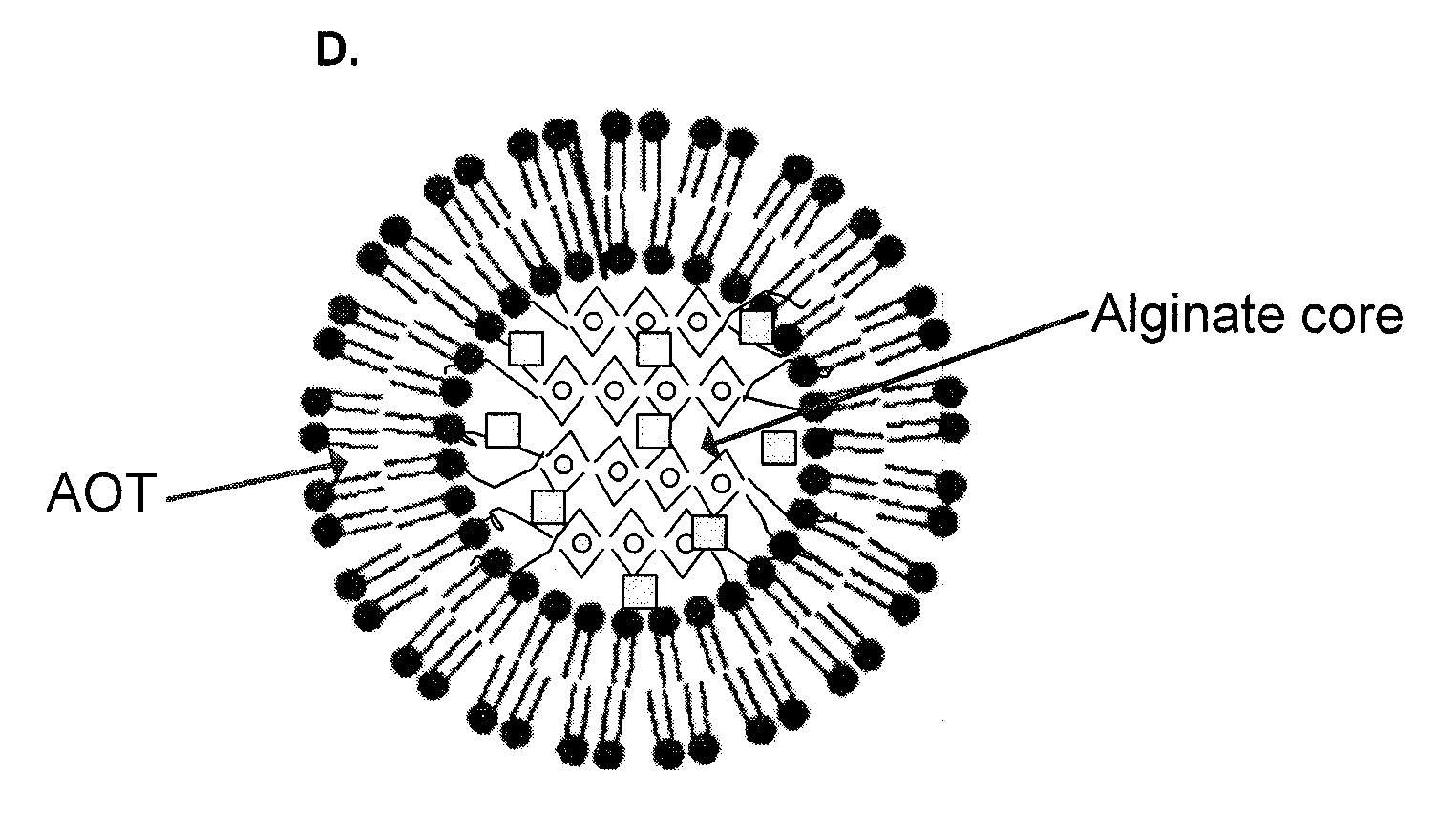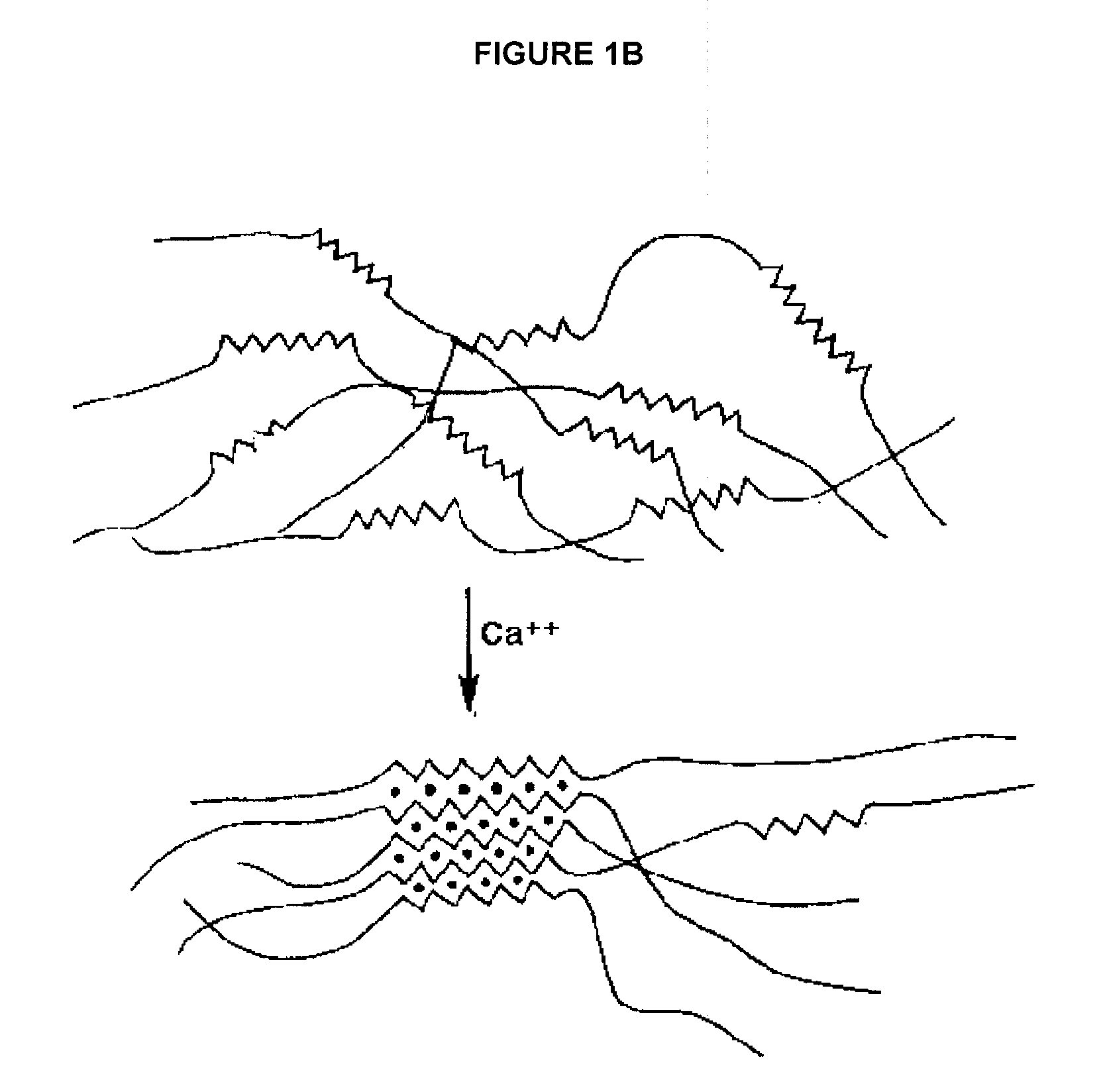Polymer-surfactant nanoparticles for sustained release of compounds
a technology of polymer-surfactant nanoparticles and compounds, which is applied in the direction of drug compositions, microcapsules, ketone active ingredients, etc., can solve the problem of limited availability of many drugs at the intracellular site of action, and achieve the effect of facilitating sustained delivery of compounds
- Summary
- Abstract
- Description
- Claims
- Application Information
AI Technical Summary
Benefits of technology
Problems solved by technology
Method used
Image
Examples
example 1
AOT-Alginate Nanoparticles
[0062]AOT-alginate nanoparticles investigated in this study were developed for efficient encapsulation and sustained release of drugs or compounds, including water-soluble drugs like doxorubicin. In vitro release studies show that nanoparticles result in a near zero-order release of doxorubicin over a 15-day period. This Example shows that electrostatic interactions between weakly basic drug and anionic nanoparticle matrix composed of alginate and AOT contribute to the efficient encapsulation and sustained drug release properties of AOT-alginate nanoparticles. Following encapsulation of weakly basic drugs, nanoparticles have a net negative charge, which stabilizes nanoparticles in buffer and in medium containing serum. This is an advantage over other nanoparticle delivery systems such as polycyanoacrylate nanoparticles that become cationic following encapsulation of weakly basic drugs, such as doxorubicin.
Materials and Methods
[0063]Materials: Doxorubicin, r...
example 2
Cellular Delivery of Water-Soluble Molecules
[0093]A novel surfactant-polymer nanoparticles for efficient encapsulation and sustained release of water-soluble drugs has been fabricated recently and disclosed in Example 1. These nanoparticles were formulated using aerosol OT (AOT; docusate sodium) and sodium alginate. AOT is an anionic surfactant that is approved as oral, topical and intramuscular excipient (U.S. Food and Drug Administration's Inactive Ingredients Database; www.accessdata.fda.gov). Sodium alginate is a naturally occurring polysaccharide polymer that has been extensively investigated for drug delivery and tissue engineering applications (Iskakov, R. M. et al., J. Control. Release 80:57-68, 2002; Shimizu, T. et al., Biomaterials 24:2309-16, 2003). The inventors have shown that AOT-alginate nanoparticles may sustain the release of water-soluble drugs such as doxorubicin and verapamil over a period of 4 weeks.
[0094]The objective of the instant example was to investigate t...
example 3
Enhancing Chemo- and Photodynamic Therapy in Breast Cancer Using Nanotechnology
[0118]This Example was performed to test the in vivo and in vitro efficacy of nanoparticle-mediated combination chemo- and photodynamic therapy in a mouse model of drug-resistant tumor. Drug-resistant JC tumors (doxorubicin-resistant mammary adenocarcinoma) grown subcutaneously in female Balb / c mice were used in the studies. As discussed below, combination treatment with nanoparticle-conjugated doxorubicin and photodynamic therapy significantly enhanced tumor inhibitory property. These findings indicate that tumors responsive to combination therapy contain infiltrating immune cells with lymphocytic morphology. The Example also demonstrates reduced tumor cell proliferation and fewer angiogenic blood vessels in treated tumors than in untreated tumors. In vitro studies on a human chemoresistant breast cancer cell line have shown that nanoparticle-mediated photodynamic therapy effectively sensitizes these cel...
PUM
| Property | Measurement | Unit |
|---|---|---|
| Diameter | aaaaa | aaaaa |
| Diameter | aaaaa | aaaaa |
| Diameter | aaaaa | aaaaa |
Abstract
Description
Claims
Application Information
 Login to View More
Login to View More - R&D
- Intellectual Property
- Life Sciences
- Materials
- Tech Scout
- Unparalleled Data Quality
- Higher Quality Content
- 60% Fewer Hallucinations
Browse by: Latest US Patents, China's latest patents, Technical Efficacy Thesaurus, Application Domain, Technology Topic, Popular Technical Reports.
© 2025 PatSnap. All rights reserved.Legal|Privacy policy|Modern Slavery Act Transparency Statement|Sitemap|About US| Contact US: help@patsnap.com



